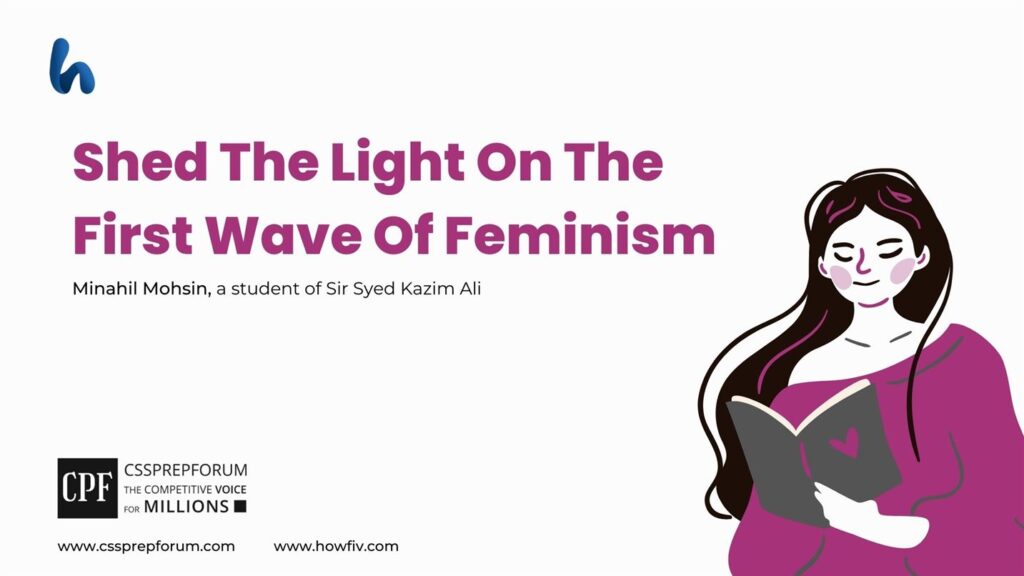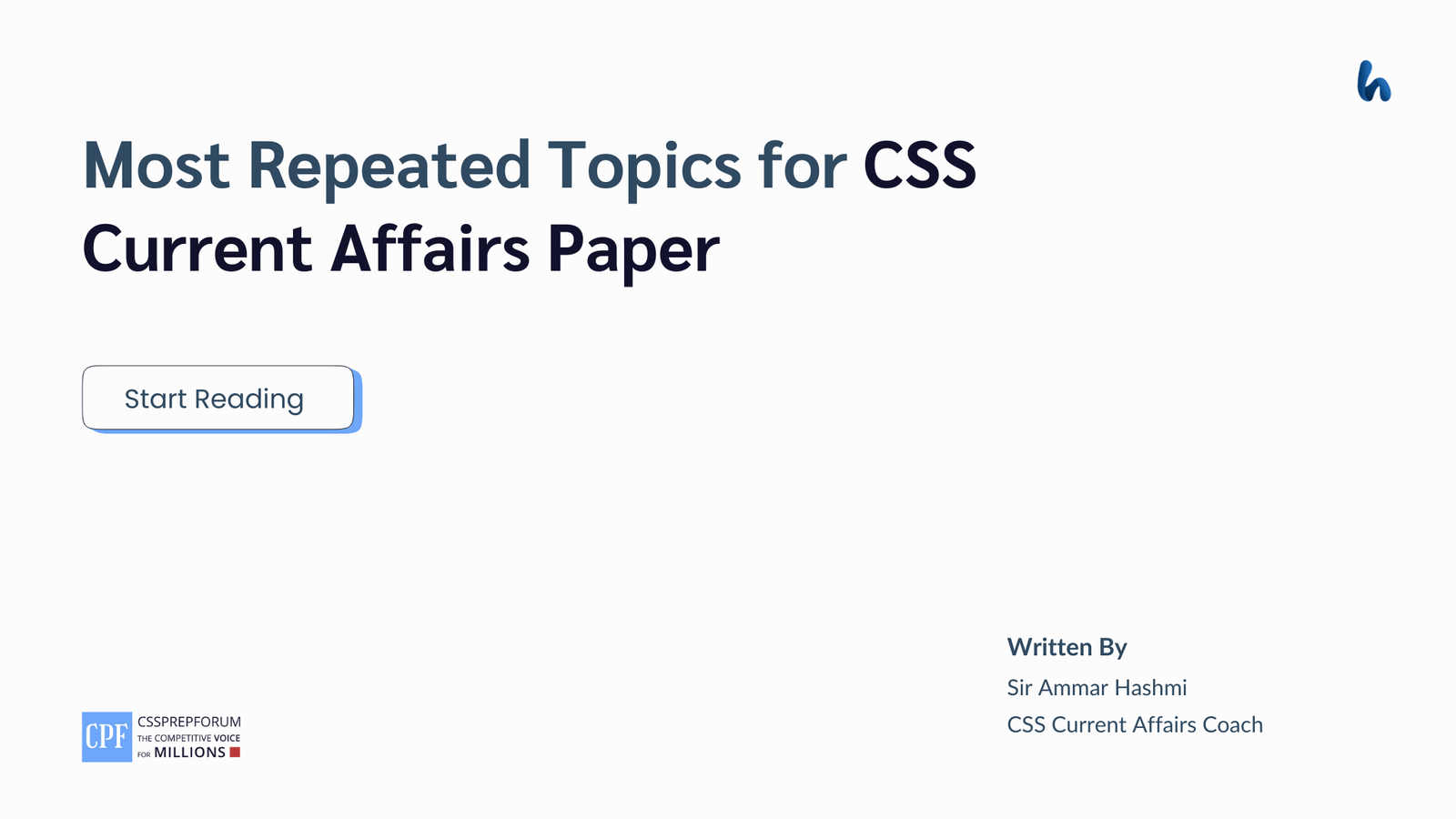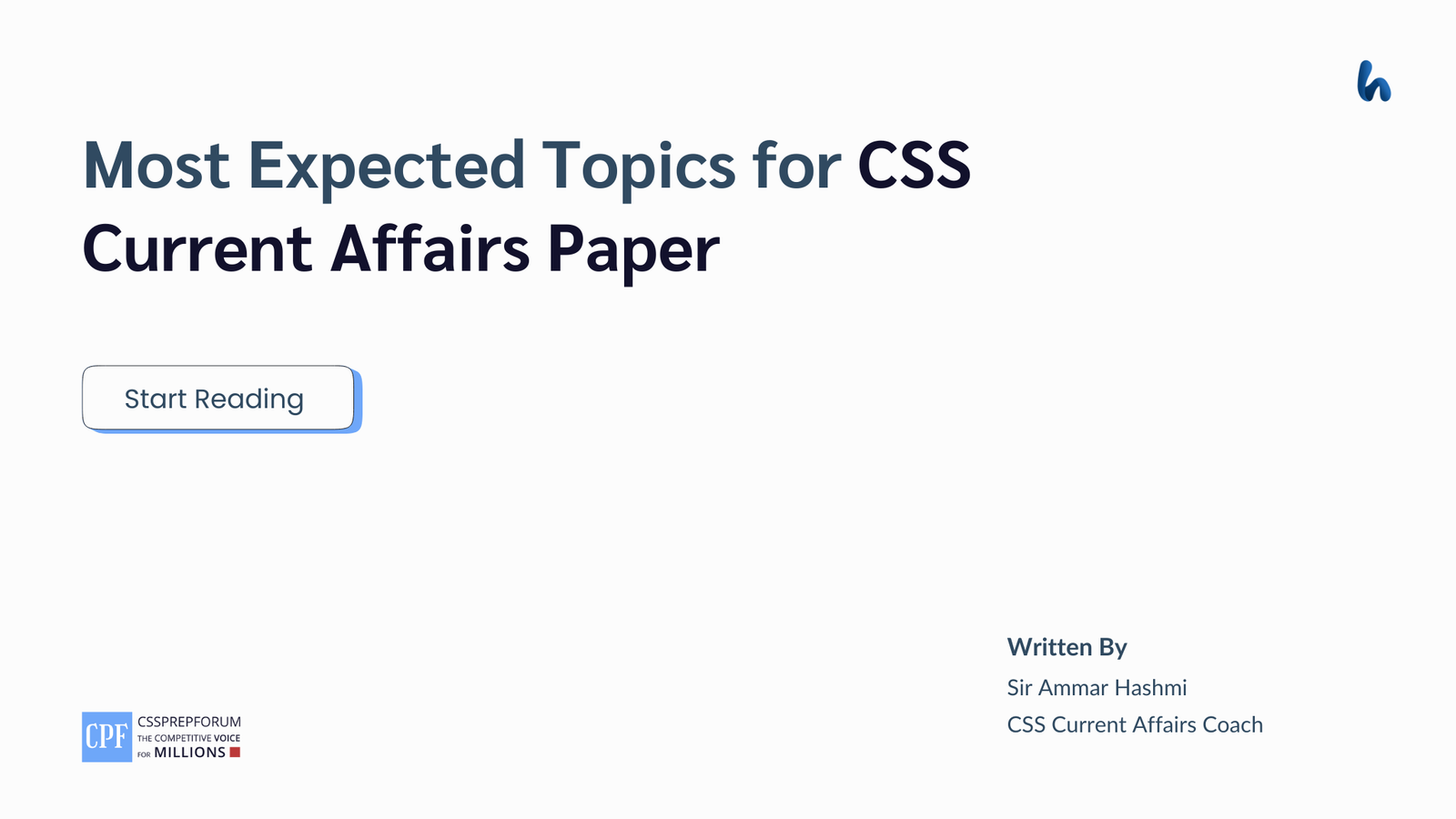The first wave of feminism took place in the late 19th and early 20th centuries, and was focused on women’s suffrage, or the right to vote. It was a political movement that aimed to gain equal rights and opportunities for women, especially in the areas of education, work, and political participation.
The article is written by Ateeqa Atia Ul Musawar, the highest scorer in CSS Gender Studies. Moreover, the article is written on the same pattern, taught by Sir to his students, scoring the highest marks in compulsory subjects for years.

1- Introductory Remarks
2- Defining the term feminism
3- Conceptually understanding how the movements take the birth.
4- Delineating the first wave of feminism theoretically
5- Historical context and emergence of the first wave of feminism
- ✓ A Vindication of the Rights of Women (1792) – a challenge to suffrage inequality
- ✓ Rock hard step of Seneca Falls Convention (1848)
- Declaration of Sentiments
- Demands under Seneca Fall Convention
6- Key features of the first wave of feminism
- ✓ Accept the innate moral and intellectual superiority of women as men
- ✓ Sophisticated Rhetoric of equality
- ✓ Reinforced the notion of Patriarchy as a fiasco
- ✓ Stop treating women as second class citizens.
- ✓ Women-a cultural emblem of deficiency
- ✓ Promoted slogan “women are human and not the traded property”
- ✓ Freedom from discrimination
7- Core concern and Objective of the first wave of feminism
8- Major proponents
- ✓ Mary Wollstonecraft-A Vindication of the Rights of Women –1792
- ✓ Sojourner Truth-Ain’t I a Women
- ✓ Harriet Taylor- The enfranchisement of Women (1851)
- ✓ Susan B. Anthony
- ✓ Elizabeth Cady Stanton
- ✓ Virginia Woolf-A room of one’s own
- ✓ Simone De Beauvoir-The Second Sex– 1949
Case in study- incident of Illegal Voting (1898)
9- The liberalist orientation of the first wave of feminism
10- Movements and organizations under the first wave of feminism
- ✓ National Women Suffrage Association –NWSA (1869)
- ✓ American Women Suffrage association-ASWA (1869)
- ✓ National American Women Suffrage Association- NAWSA (1890)
11- Success stories and achievements
12- Point of criticism
13- Conclusive Remarks

Introductory Remarks
“The relation of male to female is by nature a relation of superior to inferior and of ruler to be ruled” – Aristotle
Feminist activism has been advancing women’s rights for years under the patriarchal society. The metaphor of waves symbolizing different waves of feminism may be dated back to encompass pre-nineteenth-century to raise voice for women’s rights. The many forms of involvement that made up the first wave of feminism in the United States have continued to influence subsequent feminist movements such as second, third and then the fourth wave of feminism. The first wave of feminism truly opened debate upon the fiasco of patriarchy, unequal opportunities to women, and most significantly upon the political rights. A number of advocates and organizations played well in the journey equality to women. But despite emerging in the struggle between French revolution, abolitionist movement, industrial society, liberal politics and under the leadership of activists like Elizabeth Cady Staton, Mary Woll stone Craft, Susan B. Anthony, it took a lengthy fight before women were granted the right to vote in 1920 in USA.
Defining the term feminism
The term ‘feminism’ has been derived from the Latin term ‘femina’ meaning a woman. It was primarily used to address issues faced by women. Chiefly, the French utopian socialist Charles Fourier coined the term “Féminisme” in 1837 after the strong rise of the first wave of feminism.
- In simple connotation Feminism is defined as a doctrine which advocates socio-political, economic and all other rights for women.
- The definition of feminism under the Webster’s Dictionary is that “feminism is the principle that women should have political rights equal to those of men”
- The definition of feminism varies from one person to the next. As per the words of Chaman Nahal referring in his writing feminism in English fiction “Feminism is a mode of existence in which the woman is free of the dependence syndrome”
Conceptually understanding how the movements take the birth
Seeing through the lens of historical context, a movement always begins when there comes a contradiction between the two scenarios that is what is current situation and what ought to be. Through the perspective of feminism, the already defined status quo is that women are by nature weak and irrational as perceived by Charles Darwin. The old age stereotype that women are intellectually inferior to men is the situation globally prevailing which contradicts with situation which ought to be. Since the old centuries and medieval times women have been treated as the second class citizens.
Case in point
- ✓ In Hinduism, subjugating women remains a cardinal principal. In such society women are dependent on their protectors. The decent is traced through males only. Satee (burning widow with husband) remained a crude practice until it was abolished by Sir William Bentinck in 1828.
- ✓ In Greece, according to Athens, women were always minors, subjected to husband, father or brother. They did not have any consent in marriage
- ✓ In English Common Law, initially all the property was owned by the male heir. Woman was being suppressed and subjected to husband’s authority. It can be witnessed through the corrosive views of John Stuart Mill, that “women are slaves to men in the English system”
- ✓ In Christianity, the Christian Church used to define women as doors to hell.
Under the hood of the prevailing stereotyped notion, there was need of movement driven by specific ideology of feminism which would break the chains of restrictions around women. Thus, the ultra-orthodox and super conventional practice of subjugating women at every inch instigated the waves of feminism globally, particularly in UK and USA initially. Maggie Humm and Rebecca Walker divided waves into three forms as the first wave (1848-1920), the second wave (1960-1990), the third wave of feminism.
Delineating the first wave of feminism theoretically
✓ Historical context and emergence of the first wave of feminism (1848-1920)
Historically, the first wave of feminism drew tactical insight from women participating in different enlightenment movements such as French Revolution (1789), American Revolution (1765) and the Abolitionist Movement (1783). The roots of the first wave of feminism are connected back to the doctrine of Enlightenment of human rights as articulated in the Declaration of the Rights of Man and of the Citizen (1789). Therefore, ideas of liberalism, freedom, equality and fraternity rose under such enlightenment movements. Monarchy was challenged by the Western public, and they started viewing themselves as citizens. Among all these revolutionary circumstances, the concept of inequality to women was challenged, particularly by Mary Woll Stone Craft in the Vindication of the rights of Women (1792).
- ✓ A Vindication of the Rights of Women (1792) – a challenge to suffrage inequality
In 1792, Mary Wollstone Craft through her writing “A Vindication of the Rights of Women” challenged the discrimination faced by women. She emphasized upon the stance that women are intellectually capable and equal to men. Craft’s work laid the formal foundation of the first wave of feminism as her writing instigated the debate of equality in political sphere and ultimately leading towards suffrage movement.
Craft argued that
I do not wish women to have power over men but themselves- Mary Wollstone Craft.
- ✓ Rock hard step of Seneca Falls Convention
The struggle went as far as the Seneca Falls Convention in New York during which 300 men and women assembled for the nation’s first convention. It was outlined by Elizabeth Cady Staton, the staunch advocate of the first wave of feminism. The proponents come up with resolutions demanding
- ✓ Full citizenship of women like men
- ✓ Political equality, particularly suffrage right
That first ever convention commenced with the signing of The Declaration of Sentiments of women under the umbrella of abolitionist movement. It was created active abolitionist Elizabeth Cady Staton and Lucretia Douglass Mott after they were barred from the floor of World Anti-Slavery Convention (1840) in London. This Declaration gave rise to the movement known as Suffrage movement.
Key features of the first wave of feminism
Accept the innate moral and intellectual superiority of women as men
Some first wave feminists tracked the argument of women’s innate moral and intellectual superiority, thus empowering what might be called as the first wave of feminism.
✓ Sophisticated Rhetoric of equality
First wave of feminism accentuated the rhetoric of equality, advanced concurrently in The United States and in Europe. Under that rhetoric, feminists shared the western political framework, framework of enlightenment and liberalism, anchored with Universalism.
✓ Reinforced the notion of Patriarchy as a fiasco
Patriarchy was in true context understood as a fiasco which was non- profitable and non-rational. In spite of it, first wave nevertheless strengthened women’s supremacy and marginal societal status.
✓ Stop treating women as second class citizens
Another glaring feature of the first wave of feminism was the eradication of the practice of treating women as second class citizens.
✓ Women-a cultural emblem of deficiency
Women and men should be treated as equals and that should not be given access to the same resources and positions as men but also be acknowledged for their contributions and competencies. This is called equal opportunities or equity feminism
✓ Promoted slogan “women are human and not the traded property”
First wave feminism was the indication to achieve political equality right to vote and reproductive rights.
✓ Freedom from discrimination
Emancipation was discovered as the biggest solution, thus leading towards the equality, liberty and freedom from the discriminatory practices.
Core concern and Objective of the first wave of feminism
The first wave of feminism was the wave to protect the equality to women rights especially legal and political rights. Therefore, the first wave feminists demanded
- ✓ Suffrage or right to vote-aim to achieve constitutional amendments
Right to vote was the utmost desire of the first wave feminists to be fulfilled. The desire to equality ultimately gave the wings to the suffrage movement. The core purpose of the first wave of feminism and likewise the first wave of feminism was the achievement of fruitful result of right to vote. Right to vote was the basic objective as a number of feminists believed that root cause of the subjugation of women is connected back to suffrage right.
- ✓ Stressed upon socio-economic rights:
The first wave of feminism also sparked the debate upon the equal socio- economic rights of women. Education, equal opportunities of employment and provision of other fundamental rights remained the foremost priority of the first wave of feminism.
- ✓ Open equal opportunities for women
The very next goal of the first wave of feminism is to open the equal opportunities for women but the core concern remained the suffrage right.
Major proponents advocating the first wave of feminism
- ✓ Mary Wollstonecraft-A Vindication of the Rights of Women -1792
Craft through her writingA vindication of the rights of womenpropounded that women are intellectually inferior to men. She argued that “women are not an ornaments or traded property to be treated in marriage but human beings deserving the same fundamentals”
- ✓ Sojourner Truth-Ain’t I a Women
Sojourner Truth through her work Ain’t I a Women showed her agitation for colored women rights.
- ✓ Harriet Taylor- The Enfranchisement of Women (1851)
The Enfranchisement of Women by Harriet Taylor enlighten the issues faced by women in Victorian Britain.
- ✓ Susan B. Anthony
Incident of illegal voting in the history has sparked the suffrage movement to its full-fledged spirit. It was an incident when a number of women have been arrested and attacked after casting the vote illegally. Among them was Susane B. Anthony whose speech provided the life to equality to women.
- ✓ Elizabeth Cady Stanton
Stanton, the abolitionist figure and the leading figure of the early age movements through her Declaration of Sentiments thrust the revolutionary spark to the first wave of feminism.
- ✓ Virginia Woolf-A room of one’s own
The very next leading figure was Virginia Wolf whom through her literary work “A room of one’s own” raised a unique voice against the plight of women.
- ✓ Simone De Beauvoir-The Second Sex- 1949
The Second Sex by Beauvoir provided the detailed analysis of the oppression, discrimination and in equality faced by the half of the world’s population.
The liberalist orientation of the first wave of feminism
The first wave feminism activists are better known as the liberal feminists or egalitarian feminists for their collaborative thoughts. Like liberal feminist, first wave feminists demand equality through political and legal reforms. There should be equal opportunities both for men and women. State should formulate laws which paves the way towards equality.
Movements and organizations under the first wave of feminism
Movements began to flourish after the first wave of feminism and similarly history noticed the establishment of the various organizations to make the roots of the feminism strong. While encapsulating the whole discussion, The Seneca Fall Convention (1848) has equal significance like other initiatives. The Seneca Fall Convention was the very first step towards the trigger of the first wave of feminism. After it, a number of organizations by the staunch supporters of the feminist’s wave made the way smoother for the voice against the overpowering of men over women, subjugation and dilemma of women’s inequality. Some of the organizations which truly led the foundation of the feminism includes
- ✓ National Women Suffrage Association –NWSA (1869)
National Women’s Suffrage Association -1869 (NWSA) was one the leading organizations in the United States of America. National Women Suffrage association was formed under the National Women’s Party. This organization equally contributes towards safeguarding women’s political and legal rights.
- ✓ American Women Suffrage association-ASWA (1869)
The second most leading association to support women’s rights was American Women Suffrage Association. That organization played significant role in raising voice against the suppression of women.
- ✓ National American Women Suffrage Association- NAWSA (1890)
The merging of National Women Suffrage Association and American Women Suffrage Association gave rise to National American Women Suffrage Association. National woman’s party by Alice Paul aimed to achieve right to vote and constitutional amendments. Similarly, the new form of NAWSA also paved the way towards the reforms in the constitution regarding suffrage right. Owing to it, there were demonstrations outside the White House to achieve that aim. Likewise, Woodrow Wilson was pressurized to be in the favor of such reforms.
Success stories and achievements
The first wave of feminism was an inspiring wave of feminism for the future generation. It led towards the number of achievements which were the fundamental agendas of the first wave of feminism.
- ✓ Suffrage right granted to women in New Zealand. (1893)
- ✓ Constitutional amendment Act (19th amendment) in 1920 in the USA granted the rights to women.
- ✓ Representation of the People Act was passed in 1918 to grant the right of vote to women.
- ✓ Married Women Property Act (1870) provided the property rights to women.
Point of Criticism
- ✓ The first wave of feminism was limited to the specific group particularly middle class.
- ✓ It lacked the focus upon other social and economic rights majorly.
- ✓ It initiated the new debate of white and black feminism as the first wave of feminism particularly focused for the rights of white people. Therefore, first wave of feminism was emerged as the white feminism and left the colored women behind in the race of feminism.
- ✓ It lost its spark immediately after the constitutional amendment in the USA.
Conclusive Remarks
The earliest wave of feminism in the USA and Britain was the wave which focused primarily upon the right of suffrage, abolitionism, building the equality between men and women. The first wave focused upon elevating the social status of women by granting them all the rights they deserve. Through the strong support of the number of feminism advocates, the wave reached to its hype after the introduction of the number of reforms in the socio- political domain. Later on, that nineteen century wave introduces the debate upon the social and economic rights but with the major focus upon right to suffrage. The menace of patriarchy started to diminish through the fruitful efforts under the umbrella of the first wave of feminism. But with the passage of time, the first wave of feminism lost its spark as hit by criticism, thus leading towards second wave of feminism.

CSS Solved Past Papers’ Essays
Looking for the last ten years of CSS and PMS Solved Essays and want to know how Sir Kazim’s students write and score the highest marks in the essays’ papers? Then, click on the CSS Solved Essays to start reading them.
CSS Solved Essays

CSS Solved General Science & Ability Past Papers
Want to read the last ten years’ General Science & Ability Solved Past Papers to learn how to attempt them and to score high? Let’s click on the link below to read them all freely. All past papers have been solved by Miss Iqra Ali & Dr Nishat Baloch, Pakistan’s top CSS GSA coach having the highest score of their students.
General Science & Ability Solved Past Papers
CSS Solved Pakistan Affairs Past Papers
Want to read CSS Pakistan Affairs Solved Past Papers and learn how to attempt them to score high? Let’s click on the link below to read them all freely. All past papers’ questions have been attempted by Sir Kazim’s students, who scored the highest in the subject.
CSS Solved Pakistan Affairs
CSS Solved International Relations’ Past Papers
Have you opted for International Relations in the CSS examination and want to score above 150? Then, click on the CSS Solved International Relations’ Past Papers by Miss Abeera Fatima, the top IR scorer and the best IR coach in Pakistan.
CSS Solved International Relations Past Papers
Articles Might Interest You!
The following are some of the most important articles for CSS and PMS aspirants. Click on any to start reading.












